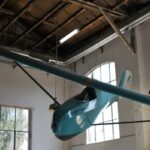The C.A.T. 20 sailplane was built in the Thirties by the Italian company Costruzioni Aeronautiche Taliedo, under Austrian license. It derived from the Huetter 17 designed and built in Austria by Ulrich Huetter in 1934. The plane was used in sail-flight schools of RUNA (Reale Unione Nazionale Aeronautica). It had a single spar wing with a leading edge covered with plywood, so that it was shaped as a torsionally resistant D frame. Compared to the Huetter 17 it had a few different details such as the vertical tail with a rounded design, steel wing support struts instead of wooden, and a better general sturdiness. In those years many thought that a glider of small dimensions was more agile, and could better use the upward wind currents, specially over the mountains. The climbing skills of the C.A.T. 20 are exceptional, but after a climb, when it’s necessary to move towards a new hot current, the little glider is almost still. Its maximum efficiency speed is only 60 km/h and any speed increase means a fast altitude loss. Over the mountains, when flying dynamically, things get better because the continuous upward currents allows it to travel long distances, even though slowly. It was appreciated for its agility and smoothness during aerobatics, but pilots needed to be careful not to exceed 120 km/h speed and 2g while maneuvering, because it was assembled with casein glue. In the Volandia Museum is exhibited I-ZAGO, property of Carlo Zorzoli, donated to the Museum by Claudio Tovaglieri and previously flying from Pavullo (MO) Airport.
Costr. Aer. Taliedo CAT-20
Aircrafts




